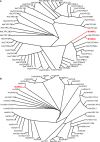Abscisic Acid as Pathogen Effector and Immune Regulator
- PMID: 28469630
- PMCID: PMC5395610
- DOI: 10.3389/fpls.2017.00587
Abscisic Acid as Pathogen Effector and Immune Regulator
Abstract
Abscisic acid (ABA) is a sesquiterpene signaling molecule produced in all kingdoms of life. To date, the best known functions of ABA are derived from its role as a major phytohormone in plant abiotic stress resistance. Different organisms have developed different biosynthesis and signal transduction pathways related to ABA. Despite this, there are also intriguing common themes where ABA often suppresses host immune responses and is utilized by pathogens as an effector molecule. ABA also seems to play an important role in compatible mutualistic interactions such as mycorrhiza and rhizosphere bacteria with plants, and possibly also the animal gut microbiome. The frequent use of ABA in inter-species communication could be a possible reason for the wide distribution and re-invention of ABA as a signaling molecule in different organisms. In humans and animal models, it has been shown that ABA treatment or nutrient-derived ABA is beneficial in inflammatory diseases like colitis and type 2 diabetes, which confer potential to ABA as an interesting nutraceutical or pharmacognostic drug. The anti-inflammatory activity, cellular metabolic reprogramming, and other beneficial physiological and psychological effects of ABA treatment in humans and animal models has sparked an interest in this molecule and its signaling pathway as a novel pharmacological target. In contrast to plants, however, very little is known about the ABA biosynthesis and signaling in other organisms. Genes, tools and knowledge about ABA from plant sciences and studies of phytopathogenic fungi might benefit biomedical studies on the physiological role of endogenously generated ABA in humans.
Keywords: comparative biology; host-microbe interactions; immunity; inflammation; metabolic engineering; natural product chemistry; signal transduction; systems biology.
Figures




References
-
- Anderson J. P., Badruzsaufari E., Schenk P. M., Manners J. M., Desmond O. J., Ehlert C., et al. (2004). Antagonistic interaction between abscisic acid and jasmonate-ethylene signaling pathways modulates defense gene expression and disease resistance in Arabidopsis. Plant Cell 16, 3460–3479. 10.1105/tpc.104.025833 - DOI - PMC - PubMed
Publication types
LinkOut - more resources
Full Text Sources
Other Literature Sources

